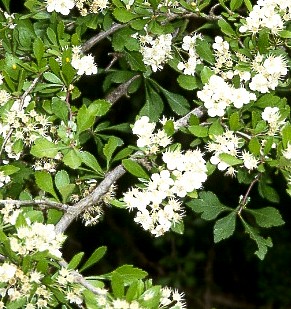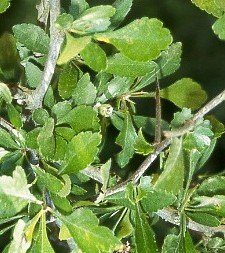

Shrub or small tree to 6 m (20 ft) in height. Crown broad, open. Bark light brown to gray, scaly. Twigs red-brown, glabrous; spines sparse, straight, to 4 cm (1.5 in) long. Leaves alternate, simple, spathulate to oblanceolate, 2-4 cm (0.8-1.5 in) long and 1-2.5 cm (0.4-1 in) wide; hairy when young, glabrous at maturity, shiny dark green above, paler beneath; tapering at base, rounded at apex, margins crenate-serrate, sometimes three-lobed; petioles winged. Flowers in corymbs, glabrous, numerous, small, approximately 1 cm (0.4 in) wide; calyx-tube obconic and 5-lobed; petals 5, white; styles 2-5; stamens 20, pale yellow; flowers appear from March to May. Fruits pomes, small, about 6 mm (0.25 in), globose, tipped with persistent reflexed calyx, bright red; nutlets 3-5, slightly ridged and smooth; fruits mature in October.
Distribution: Oklahoma and Texas, east to Florida north to Virginia and west to Arkansas. Scattered to common in Oklahoma.
Habitat: forest understory on moist soil.
Comments: Crataegus is from the Greek meaning "flowering thorn"; spathulata refers to the spoon shaped leaves.
Field identification: if fruits are not present, little-hip hawthorn can easily be confused with blue haw (C. brachyacantha). The leaves are very similar. The leaf veins of blue haw extend from the midrib to the lobes and sinuses; veins of little-hip hawthorn extend only to the lobes. Identification is much easier when fruits are present; blue haw has dark blue fruits and littlehip fruits are bright red.
Wildlife benefits: In general, the fruits of hawthorn species are eaten by several species of birds.
NWI status: FAC, FACW.
Distribution in Oklahoma: 
BACK
NEXT
RETURN TO INDEX
Last update: 9/9/99
 Go to Oklahoma Biological Survey Home Page
Go to Oklahoma Biological Survey Home Page
 Disclaimer
Disclaimer